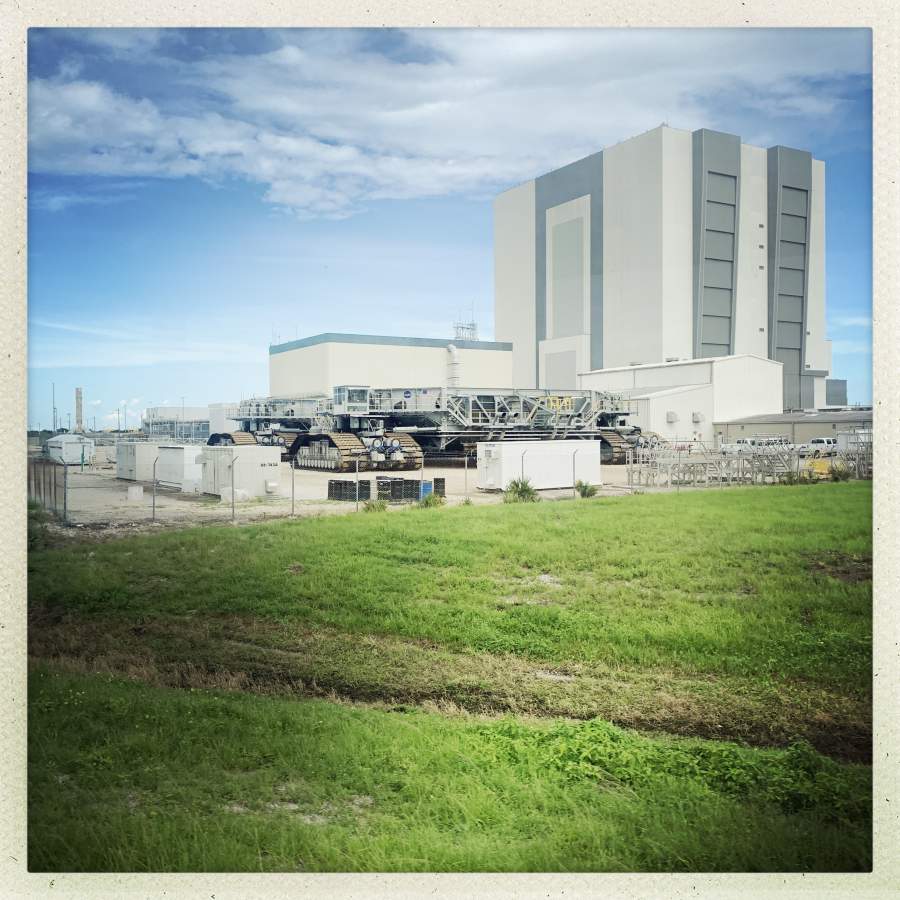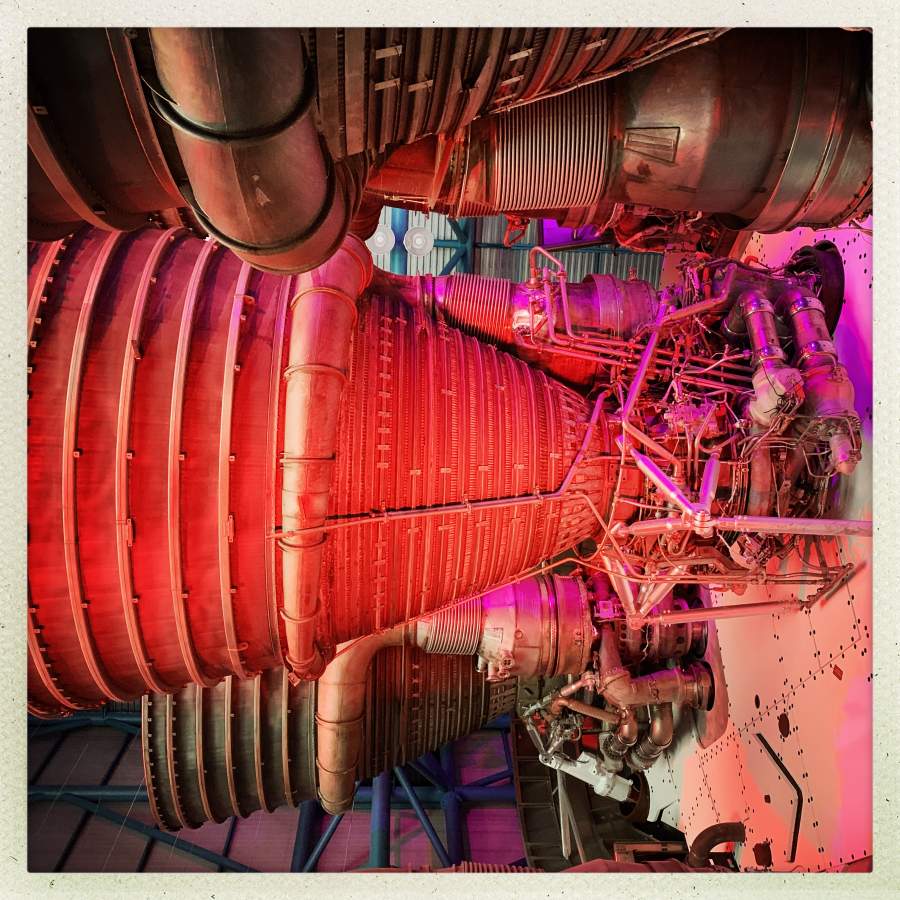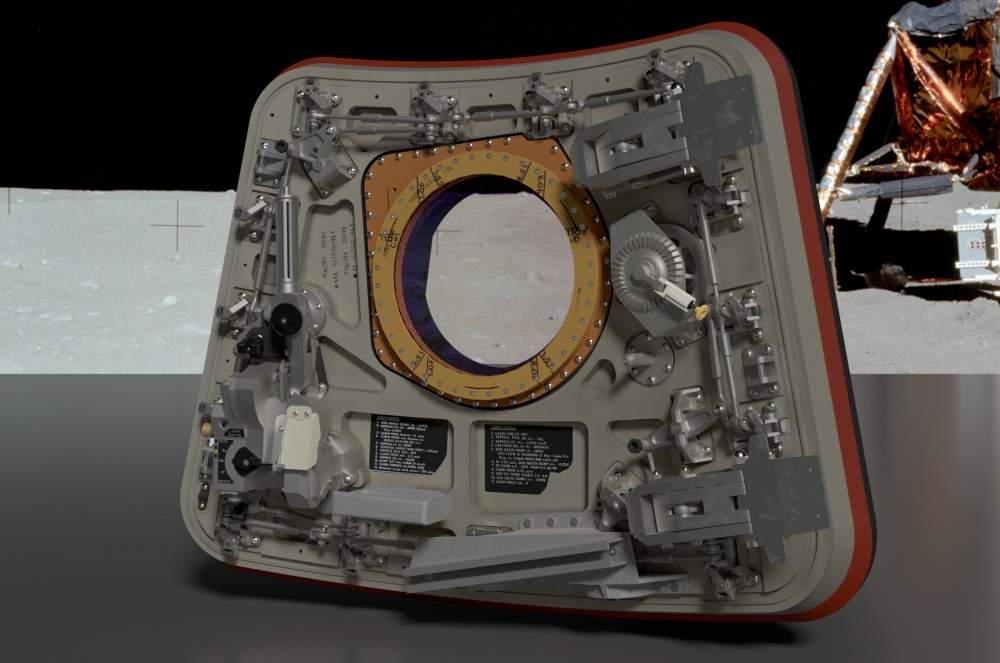NASA’s done a good job producing a sort of “space disneyland” – probably for the usual reasons: it’s necessary to attract kids’ attention. It drives me a bit nuts when I see things being dumbed down for kids because their parents can’t handle it.
These are life-size mockups, mostly, though some of the components are real. The real stuff is too valuable to have sitting out in the rain. It’s a pretty cool display – you can get a sense of the towering size of these machines.

The rockets are not bent, that’s panorama mode
F-1 engine. (I believe it’s a mockup) – I love standing there and trying to figure out how they work. They’re full of mechanical control/feedback systems. They are attached to the bottom of the rocket (5 of them) on massive gimbal systems that allow them to be angled; when I was a kid one of the things I wondered was how the rockets could fly under control (the Estes toy rockets I built sometimes did not go so straight) – that’s how.

The big donut-like collar thing around the engine is one of my favorite parts of it – it’s the oxygen feed system. On the other side of the engine is the high pressure liquid oxygen turbopump, which pushes liquid oxygen down a pipe that curves around the bell, getting smaller as it gets closer to where it meets on the other side. It gets smaller because, as the oxygen is blasting out into the bell, its pressure drops, so the diameter of the pipe is manipulated to maintain a constant pressure. I’m sure someone had fun calculating that with a slide-rule. (I know, it’s just calculus, but calc II was as far as I got, so I think that’s pretty fancy thinking).

The big thing on the upper left of the engine is the oxygen turbopump.
If I recall correctly, the pump did not have to get the liquid oxygen moving at supersonic speeds; that was taken care of by the bell – as the oxygen flows into the bell, it follows the bell, which has a larger surface area and makes it expand; the gas goes supersonic inside the bell as a result of that expansion. The point is not that that is cool (which it is) but that the high pressure turbopump is pumpin’ some #*!@!*!*#ing oxygen really fast.
The triangular things at the top are the linkages for the gimbals, which move the engine around. Those connectors are big turnbuckles that allow them to be carefully adjusted and aligned. I have absolutely no idea how a rocket’s engines are aligned and calibrated but you can imagine that’s a really important process.

That’s one of the crawlers, parked outside the vehicle assembly building (VAB). The VAB is big. See the squarish indentations on the darker gray pieces along the side? Each of those indentations is the size of a football field. It’s not hard to get good pictures of the VAB because if you are taking pictures anywhere within a mile of the VAB, the VAB is in the picture – it’s that big. The crawlers go 1 mile per hour over a special road built for them that’s similar to an ancient roman road: layers of concrete then layers of sand then layers of gravel. They told us that each of the links in the crawler’s tracks, which are forged steel, weighs a ton. Look at the little pickup trucks parked next to it. It’s hard to get a sense of scale.
NASA has constructed an entire building to house a complete Saturn-V moon rocket; it’s made up of unused parts and some used ones including the crew capsule of Apollo 11. There’s this gigantic space you can walk through, full of insanely cool artifacts.
This is a side-view of the back of the Saturn-V that’s lying on its side in the building; through the cluster of engines on the back. It’s a bit hard to really feel how big it is – it’s a couple of stories tall lying on its side.

Each Saturn-V cost what an F-35 costs today. Adjusted for inflation, it’s more expensive but not by a large factor.
The building housing the Saturn-V is the old command building; the old “capcom” (Cape Canaveral Command) is still in place and they have turned it into a museum. The details in the museum are delightful: there are two coffee tables at each end of the room (no drinking coffee at your workstation!) that look like they were being used to smoke and drink coffee just a few minutes ago.

If you’re a space junkie, there’s a cool podcast that BBC recently did called “13 minutes” [bbc] that explains all the radio chatter and what it means during the final descent, and the significance of all of the little decisions that the astronauts had to make. It’s fascinating stuff if you’re a tech nerd. Here’s a teaser/spoiler: when you hear capcom say “we are go for R46″ that is telling the astronauts to punch in program load-point R46 into the flight computer” – the computer had all the detailed operations hard-wired (they explain what “hard wired” means) into it. The astronauts and the computer were symbiotic – they used the computer as a set of functions that it could do, while they worried about what they had to do.
I didn’t get a picture of the egress door of the Apollo-11 capsule but it impressed me with its complexity. There’s a single handle that controls a web of actuators and rods and clamps, and you can remove the whole thing with one pull. Bill Cheswick, Anna, and I had a bit of a boggle as we pondered how it was designed and by whom. It turned out, when I got home and checked on youtube for my usual channels, that Adam Savage has been leading an art project with machinist and fabricator youtubers to make an exact replica of the door. [collectspace] So I got to watch This Old Tony mill the actuator mount that you can see at the upper left of the door:

That’s a rendering of the 3D model Adam’s team are working from. I notice that the actual handle is missing – it’s what goes in the recess to the upper left, just to the left of the porthole. That’s just how my brain works: I don’t know what day of the week it is but I notice something like that.
[Edit: somehow I forgot this picture.]


Also: I had one hour in which to explain to 2 dozen high school girls about syslog and how everything logs stuff about everything, and you can learn tremendous things by correlating logs in sequence and matching them to a theory of an event. As I was talking, I realized how “over” internet security I am; it’s a topic I have been trying to get people excited about for 30 years and now we’re just finally starting to see auditors insist that people turn logging on their devices.
Unrelated but related to syslog: I wonder if the New York City power outage has a lot of people looking through their event logs, wondering it was a demonstration of a cyber-capability. I’d rate the odds at almost 20%.
There was a lot of “let’s go to Mars!” stuff, which I understand. But it grated a bit. I would prefer to see “let’s turn Earth back into a garden” but that’s too late and “let’s get rid of all the politicians” isn’t going to happen either.
SpaceX has a “feel the heat” rocket launch viewing tour package, which gets you as close to the launch as is legally possible. If I had a bucket list, this would be on it. I expect I’ll go for a launch this fall. [spacex]
Penn Jillette: “Set your motherfucker to receive” – [jil] a pretty funny take on witnessing rocket launches. It has one of the best oblique jokes about what a poseur Penn can be, which is really funny since it’s coming from Penn.

Yabbut – – – the Saturn V worked. IINM, not one Saturn V failed, ever.
fusilier, who got the best 20th birthday present ever, back in 1969
James 2:24
fusilier@#1:
Yabbut – – – the Saturn V worked. IINM, not one Saturn V failed, ever.
Supercruise: check
Stealth: negative
Bomb load: Zero
Success Rate: 100%
The Saturn V was one of the high points of human stuff-building, and established a waypoint that anything great we want to build, ever, will have to meet or exceed.
Thanks for sharing this, I’d love to visit one day – I love space stuff, even if it is dumbed down, but I especially love seeing and feeling the scale of these kinds of technologies.
At the AIr and Space Museum in DC, they have (had?) one and a quarter Saturn V thrusters, arranged with mirrors so you could see how big all five would look. Pretty clever.
In the last few years, I’ve gone from a “it’s time to make the next big leap” manned exploration nerd to a “Eh, maybe even robot exploration is too expensive.” Engineering/science/political/economic know-how is a finite resource, and we need to spend pretty close to 100% of it on preventing us from cooking ourselves.
brucegee1962@#5:
Engineering/science/political/economic know-how is a finite resource, and we need to spend pretty close to 100% of it on preventing us from cooking ourselves.
Yes, and damn them for wasting it on nukes and F-35s.
If you’re interested in the different types of rocket motors (including the F-1) and how they work, here’s a great explanation: https://youtu.be/LbH1ZDImaI8
@Sunday Afternoon: now I am going to save that for after dinner with a glass of red wine. Thank you!
Worth noting a couple things, I think.
1. The Saturn V is a triumph of engineering management more than anything else. There was none of this “the engineers are worried about the O-rings in these temperatures -> well, fuck the engineers, we’re launching on sched.” business.
2. The engineering manager in question was Wernher von Braun who made his nut building V-2s with slave labor, although it’s not 100% clear a) whether he was a loyal Nazi at all or b) whether he had a hell of a lot of choice in the matter.
There is anyways an ethical cloud over much of early NASA work in general, and the Saturn V specifically.
It was super easy to dismiss all the Nazi Science that was scientifically crap (i.e. lots and lots of it) but it turned out to be a lot harder to dismiss the stuff that worked. I dunno what to make of it or what the right way forward might look like. Maybe just take a moment of silence for the slaves of Peenemünde when you visit the Rocket Garden? But probably we ought to anyways remember.
huh. I didn’t realize the whole rocket engine assembly was adjustable, I just sorta figured they used flaps on the fins or something to adjust course (in my defense, I haven’t really thought/read about it much)
I tend to get a bit irritable and into internet arguments when people start talking about space colonies or interstellar travel. I don’t think many people realize how inhospitable to human life space is.
@lochaber – Von Braun’s V-2 had a little graphite rudder in the jet stream coming out of the engine. If you watch the slow motion Saturn-V launch on youtube you can see the F-1s finding their steady-state on the gimbals. It makes me weak at the knees, it’s so cool.
– Tom Lehrer
[
]
You have one thing incorrect about the F-1 engine, Marcus. That ring around the nozzle extension didn’t carry oxygen. In fact, it’s the turbopump exhaust, i.e. combustion products of the turbine that drives the fuel and oxygen pumps.
That exhaust is relatively cool, fuel-rich and therefore sooty. The reason it’s directed that way (rather than just dumped out an exhaust pipe as in some other engine designs) is to provide coolant for the nozzle extension. It creates a film layer along the inside surface of the bell, preventing contact with the super-hot gasses coming out of the thrust chamber. If it weren’t there, the nozzle wouldn’t survive the 180 seconds those engines ran.
It’s also the reason for another phenomenon, namely the fact that the exhaust plume from the F-1 appears dark, nearly black, for some distance below the nozzle, until the hotter, incandescent gasses burn through the sooty layer. This is easily seen in any of the close-up films of a Saturn V launch.
What may have caused your confusion is that the LOX was fed from the turbopump through channels around the upper part of the F-1 nozzle and thrust chamber as a coolant. In fact, those channels were the engine — it was just those pipes braised together. From there the LOX was fed to the thrust chamber, where it mixed with the RP-1 (kerosene) fuel and burned to do the real work. But the “doughnut” wasn’t part of that system.
The whole design was incredibly clever for its time, but has been surpassed by modern engines (especially in efficiency). By the way, the only machine that ever used F-1 engines was the S-I, i.e. the first stage of the Saturn V.
Sunday Afternoon@#7:
If you’re interested in the different types of rocket motors (including the F-1) and how they work, here’s a great explanation: https://youtu.be/LbH1ZDImaI8
That really was great. Very instructive. He crammed so much interesting stuff in there that it hurt my head and I’ll have to watch it again.
It had the same kind of “mind blow factor” as that walkthrough on youtube of how the SR-71’s engines worked. “How did they think of that!?”
DonDueed@#13:
Yeah, I had that wrong – and that was a big “one thing”! The video Sunday Afternoon recommended explains it pretty well (though simplifying it a lot) and now I understand better.
Richard Feynman famously said (about the Manhattan project) “there was not a lot of science just a lot of engineering” and this matter of building rocket engines sure sounds like a lot of rocket engineering.
I had not realized how woefully ignorant I was; I didn’t even understand how the turbopump worked and what powered it. “Wow, holy shit!” was pretty much that.
I would hope not, as i understand it supersonic liquids are not a good idea. Super sonic liquid oxygen sounds like a particularly bad idea
@fusilier given they only launched 13 of them they could have had a hypothetical failure rate of 5%. even at a hypothetical 10% they could have gotten lucky. there just isn’t the sample to talk about the rockets reliability.
personally i’m more impressed by the Soyuz, that thing has been seriously tested.
Small correction: the F-1 engines ran for 150 seconds, not 180 as I stated above.
There’s a really incredible story about a nearly-fatal design problem with the F-1. In early tests they were regularly blowing themselves up. The problem was combustion instability, which essentially caused monstrous uncontrolled pressure oscillations. In those days they didn’t have the computer power to simulate the problem and potential solutions, so they did it by trial and error, changing the size and angle of the hundreds of little LOX and fuel orifices (adjusting the impingement angle), adding baffles in various positions, and so on.
Eventually the problem went away and they got smooth combustion, but there was no way to prove it was really fixed. So they came up with a test procedure: they placed small bombs inside the thrust chamber and set them off while the engine was running. They figured if the pressure transient from that didn’t trigger the instability, they were good to go. It didn’t. No F-1 engine ever failed in flight.
Marcus: yeah, lots of rocket engineering.
All the turbopumps had to do was deliver the fuel and oxygen into the thrust chamber. But they had to do so at high enough pressure to overcome the enormous pressure of the combustion itself… and at a rate of three tons per second. For the S-I stage as a whole, that was fifteen tons per second for 150 seconds. That’d keep your kerosene lantern burning for a while.
Kinda trivial in the midst of the magnificence, but see BPS.space for a clever hobbyist determined to build model rockets with a gymballed engine and capable of a soft landing.
marcus (#15) wrote:
DonDueed (#18) wrote:
Yes! I had a passing familiarity with “turbopumps” used in high vacuum applications – these are electrically powered and take a lot of power. I had sort of assumed the same for rocket engines without really thinking about it. What?, there’s actually a small combustion chamber that drives the pump.
Mind blown!
The F1 has struck me as a sort of triumph of what happens when you ask a rocket guy “so, how should we power ${thing}?”
The answer was always “maybe some sort of rocket engine?” Which is pretty predictable in hindsight.
Some time in the past few years there was an F1 test firing video going around. The usual huge flare and VOOSH noises, and then they mention that this isn’t actually the engine. It’s the engine that powers the turbopump for the engine and your head explodes.
We visited some time in the mid 80’s and I think I wandered around with my mouth hanging open the whole time. The crawler with its own road seemed impossibly big and the capsules where the astronauts sat seemed impossibly small and full of complicated controls. We enjoyed it so much that we cancelled Disney World and went back a second day.